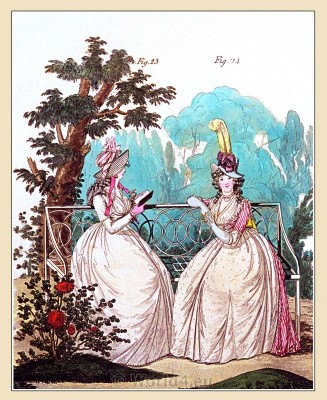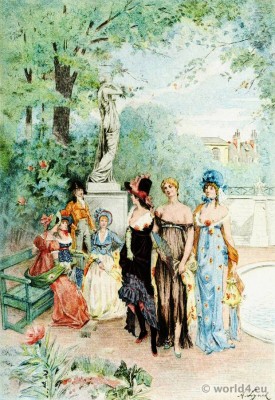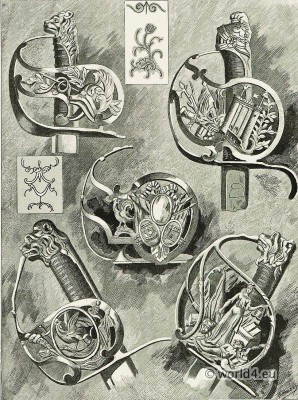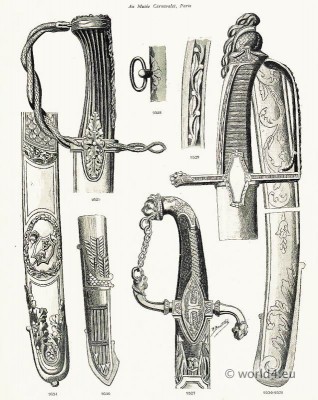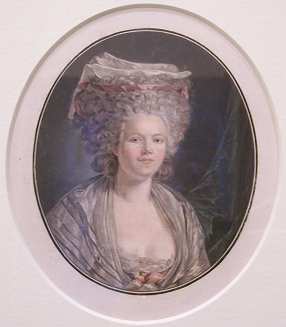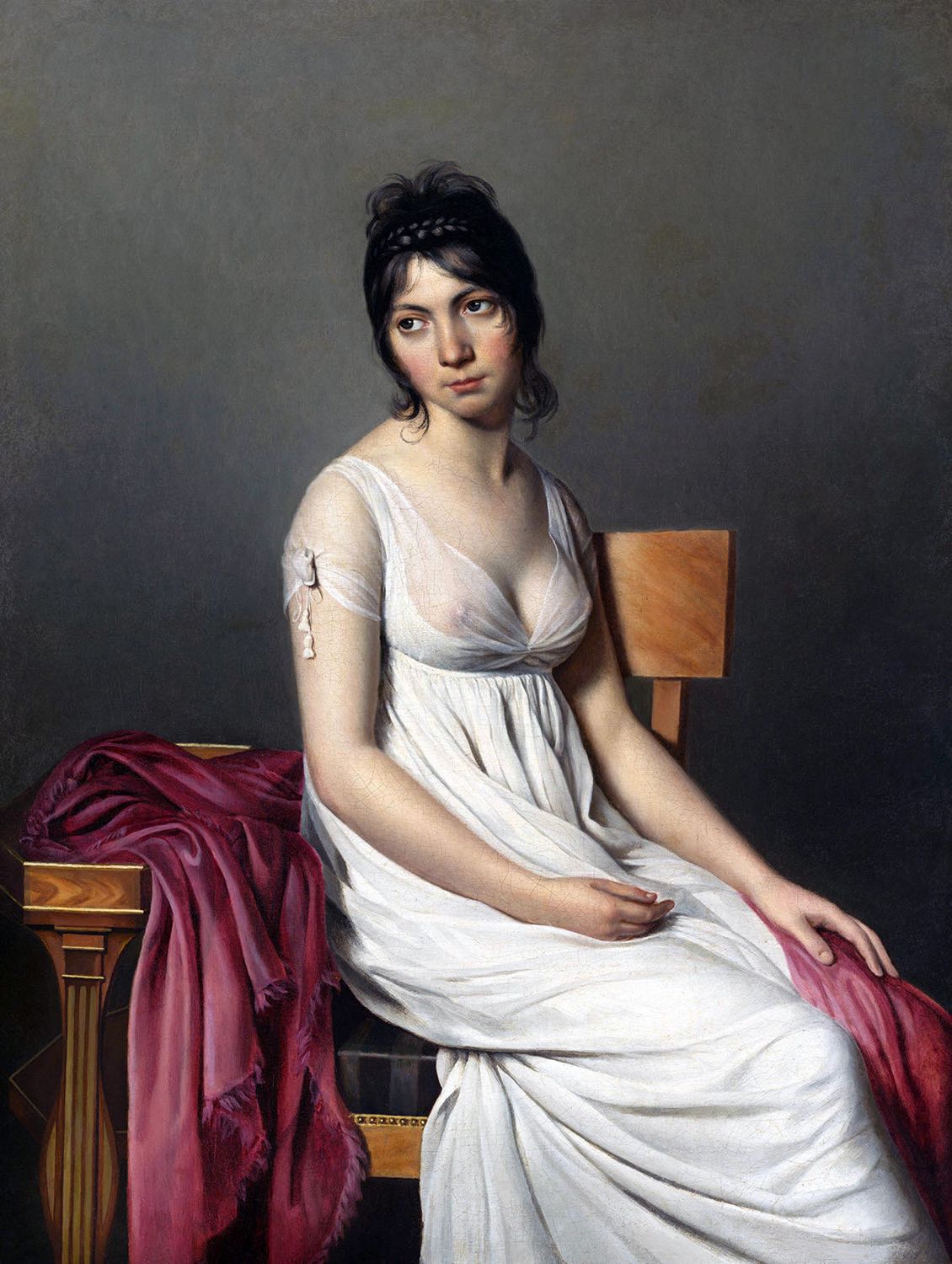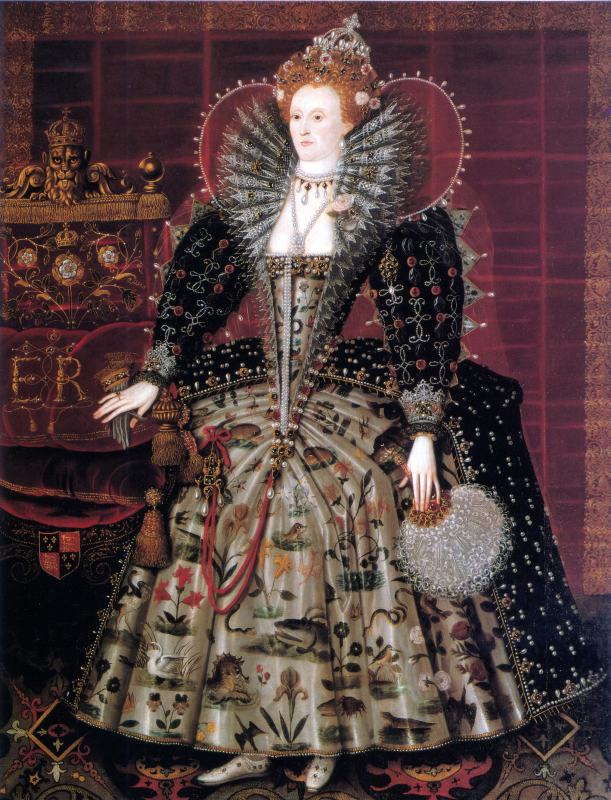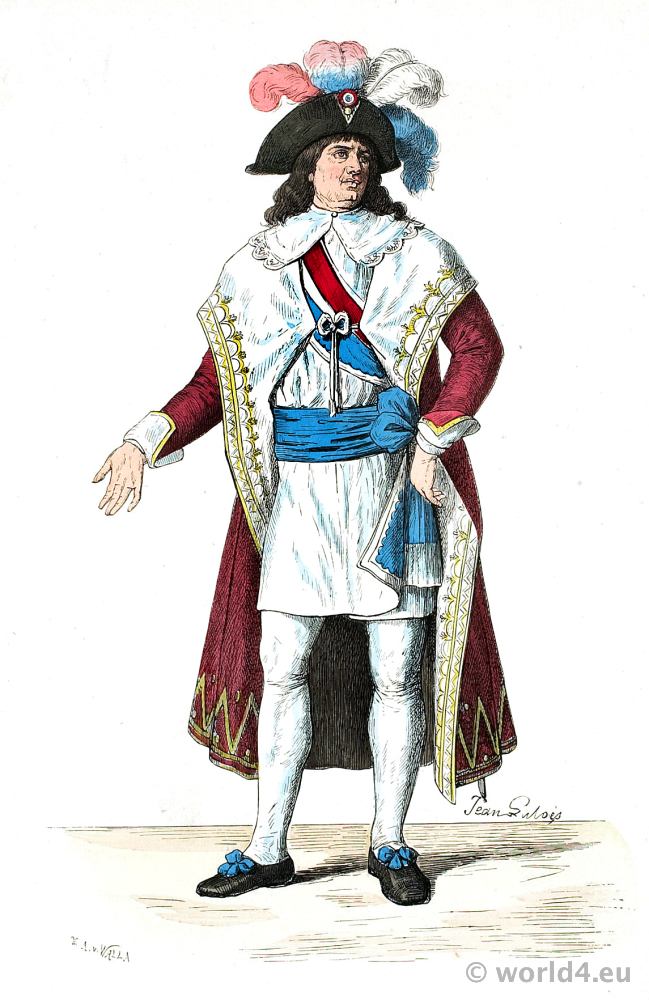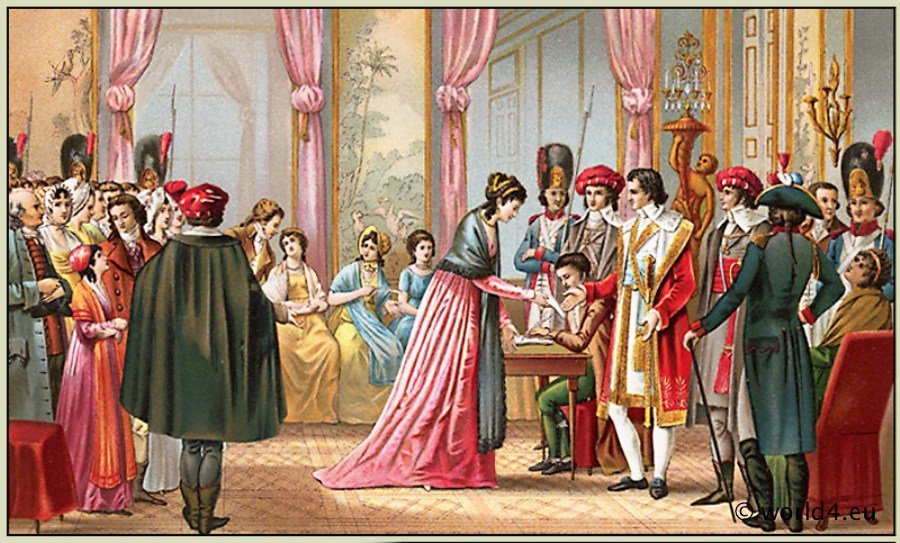
FASHION IN THE DAYS OF THE DIRECTOIRE.
The days of the Directoire by Alfred Allinson with a note upon the costume of the period by John Colby Abott.
Table of Content:
Costume under the Revolution; Versailles no longer the arbiter of the mode – Anglomania, “Anticomania,” Rousseau, and a “return to Nature ” – Blonde perukes – Dresses à la Flore, à la Diane, etc. – The classical cothurnus; the “balantine ” – Pink silk tights and gauze veiled nudities – Impossibles and Incroyables; masculine dress à la Anglaise – Official costumes of National Representatives and of Directors – Barras’ little joke – A lady on contemporary fashions in Paris.
Costume under the French Revolution
LOVE of costume seems innate in humanity – and, above all, in French humanity. Even in the Revolutionary period itself costume played its part-opposed as any such weakness might appear to be to the stern ideals of “Republican simplicity.” The patriots of 1789 and 1793 were often not superior to a sneaking fondness for theatrical display, for “dressing-up,” and even under the most democratic of democracies officials were seen decked out in tricoloured scarves and plumed hats.
Members of the Convention wore the former as the token of their dignity, and such as were despatched from time to time as Commissioners to the Armies in the field added a hat with feathers of the same brilliant hues. So, too, the judges of the Revolutionary Tribunal boasted badges of office and those great hats with black plumes with which we see them affublé in old prints representing the trial of Marie-Antoinette. In fact, was not the carmagnnole complète itself a concession to the same craving after effect, and the red cap of liberty?
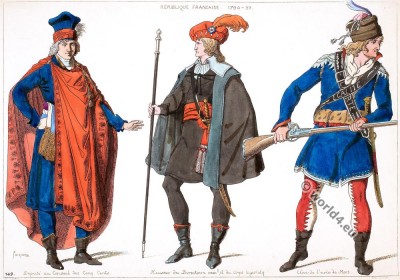
Versailles no longer the arbiter of the mode
After the 9 Thermidor and the subsequent establishment of the Directoire these tendencies had full and free play, and we find all Paris – or at any rate all the wealthier part of the population of Paris, and, above all, the newly enriched classes – indulging in a wild orgy of extravagant self-adornment.
All sense of restraint and moderation seems obliterated for the time being; nothing is too far-fetched or bizarre, too grotesque or even indecent, to become the rage. The fashions no longer come from Court, Versailles has lost her empire over the mode; there is no Court, and the Palace of Versailles stands empty and deserted. Caprice rules the roost instead, and that at an epoch when all reverence for tradition, all feeling of respect for the past, almost all sense of artistic no less than moral obligation, were in abeyance.
Anglomania, “Anticomania,” Rousseau, and a “return to Nature”
The chief factors, so far as there can be said to have been any fixed factors, determining the dress of the period, were Anglomania, and still more markedly “Anticomania ” – the mimicry of everything English, particularly in the fashion of male attire, and the imitation, not to say the travesty sometimes, of classical models, of the robes of ancient Greece and Rome.
Add to these the still lingering effects of Rousseau’s teaching that mankind should endeavour to return to the simplicity of natural conditions, and taking this fad for its pretext and excuse, the mere “superfluity of naughtiness,” in those days of loose and profligate living, when religion was scorned and most of the old moral restraints relaxed, which urged women to make a more and more free exposure of their charms.
Ostentatious luxury, extravagant display, novel and costly dress, reckless dissipation, unrestrained by any rule, unchecked by any canon of good taste, unchastened by any example of higher and more refined circles, were the strongly marked characteristics of the Society of the Directoire.
“Up to the date of the taking of the Bastille the dictates of fashion had always been issued from Versailles. Versailles was the arbiter elegantiarum, the incarnation of the mode; and Mademoiselle Bertin resorted thither to discover one day what Paris was to wear the next. Under the Revolution all is changed; fashion is democratic now and common property; its tyranny is exercised by all and sundry, each in turn, and in this anarchy of taste, over which Madame Tallien reigns without governing, the individual initiative of caprice and coquetry succeeds to the omnipotence of Court example. “Freed from the constraints of yesterday, fashion harks back to the models of Greece and Rome, and, encouraged by the patriotic school, returns to the costumes that were in vogue in days before Christ.
Fashions are borrowed from all quarters of the world; but of all these adaptations, none are so important and so rapidly successful as those taken from Great Britain; none make more perverts among the fair Parisiennes from the Classic tunic. Anglomania is in full bloom; ‘ whatever is not touched with anglomania is proscribed by our merveilieuses as something vulgar and uncivilized, fit only to give a fashionable lady the vapours.’
On the other hand, everything coming from this country, with which the Republic is at war, is fêted and applauded. In the same way Prussomania had reigned in France during the Seven Years’ War, and we took our revenge for Rosbach by wearing none but hats à la Frédéric. Turbans, shawls, hats, spencers ‘a delicious costume,’ are appreciated by Republican elegance only when they have travelled across the Channel.
“Nevertheless this anglomania, much honoured as it is, is rather a momentary diversion than a lasting innovation in costume; anticomania is and remains the true and permanent expression of the mode. The idea once started, the principle of social change admitted, inspiration and model were ready to hand.
Greek and Roman antiquity, of which the new Republic endeavoured to be the heir in everything, were the obvious sources from which this revolution of outward show must draw. Was not painting prepared to give the appearance and costume of the Athenian and Roman lady? – and David (Jacques-Louis David) to represent how matron and virgin and citizen were to be attired? ” *
(* Edmond et Jules de Goncourt, Histoire de la Société française pendant le Directoire, (1855), ch. 13, p. 409.)

The Terror proscribed blonde perukes
Then there is another point to be noted. This was a time of reaction, as we have already seen on several occasions – reaction, both political and social; and these reactionary sentiments strove to find expression in the dress and fashions of the day. Hence the blonde perukes which the fashionable world wore as rather ghastly mementoes of dead friends sacrificed to “la sainte guillotine,” and the bals à la victime, where every guest wore crape in memory of some relative who had perished during the evil days now overpast.

“The Terror proscribed blonde perukes, and the speech of Payan in the tribune of the Commune will be remembered: ‘A new sect has just been formed in Paris, eager to combine with the anti-revolutionaries, and giddy-pated women hasten to buy the hair of young fair-haired victims of the guillotine, and to wear on their heads these relics so suggestive of fond memories.
The blonde peruke gains instant and universal vogue as a protest against past misgovernment. Blonde are the twelve perukes forming part of the wedding trousseau of Mademoiselle Lepelletier Saint-Fargeau; blonde of all shades, from chestnut to gold, from childish flaxen to pronounced red, are the thirty perukes, at twenty-five louis apiece, of Madame Tallien, the thirty of Mademoiselle Lange, the thirty of Madame Raguet.

Dresses à la Flore, à la Diane, etc.
… Gowns à la Flore, dresses à la Diane, tunics à la Cérès and à la Minerve, coats à la Galatée, frocks au lever de l’Aurore, costumes à la Vestale are all the rage … .
As for foot-gear, the classical cothurnus is the god of the moment, fastened with an acorn clasp at mid-leg; and for twenty crowns Coppe will make it of “a colour, freshness, eloquence, poetry” to be worthy of the foot of the fairest, even of Madame de Staël herself.
If next day you bring him back a torn and burst cothurnus, the artist, after looking, handling, scrutinizing, after shaking his head sagely like a man who seeks in vain for a reasonable explanation, suddenly taps his forehead after an impressive silence, and as if illumined by a sudden and brilliant idea: ‘ Why, good heavens!’ he will cry, ‘I wager fifty louis Madame has been walking!’
“In this restoration of Olympus, the Impossibles of the new France find themselves so far emancipated from all restraint that they set to work to arrive little by little at the nude! The robe shrinks away further and further, exposes more and more of the bosom; the arms, once muffled to the elbow and therefore suspected of being lean and unlovely, are stripped to the shoulder. Then legs and feet follow the same example. Jewelled thongs encircle the ankles –
Le diamant seul doit parer Des attraits que blesse la laine, (“The diamond alone should adorn charms which the stocking offends.”) while gold rings are worn on the toes.
Directoire. Gauze veiled nudities.
Fortunée Hamelin, known as Madame Hamelin, born Jeanne Geneviève Fortunée Lormier-Lagrave, on the island of Saint-Domingue, on 25 March 17761 and died in Paris on 29 April 1851, was a woman of spirit who was classified among those named the Merveilleuses du Directoire.
If she did not enjoy the fame of a Mrs Tallien or a Mrs Récamier, this friend of Josephine de Beauharnais, a Creole like her, was an extraordinary woman. By her intelligence even more than by her beauty, she seduced and influenced more than one eminent character, from Bonaparte to Louis-Napoléon, from Talleyrand to the Duke of Choiseul, or from Chateaubriand to Victor Hugo. From the Revolution to the Second Empire, she was exposed to everything that France had to offer in terms of political, military, literary and artistic figures.
In the progressive course of this fashion for diminishing the costume more and more every day, various maladies carry off the weak and delicate members of the sex. Doctor Desessarts declares, ‘he has seen more young girls die since the introduction of this system of gauze-veiled nudities than in all the preceding forty years.’
The survivors go on heroically wearing this costume only fitted for climates that know no rigours. Nay! they push things farther still; and the Terpsichorés of the jardins d’été, clad in pink silk tights closely fitting and a shift of semi-transparent lawn, expose to view’ their legs and thighs encircled with diamond-studded hoops.’
Scarcely do the chills of winter force some addition; reluctantly they throw about their bare shoulders a sleeveless satin coat with collar of marten-fur. A strange and at the same time charming effect is seen in some of the miniatures of those days, where this costume à la Grecque is surmounted by a jockey-cap of puce velvet.
Before long the fair innovators begin to revolt against silk and wool, complaining of their harsh, rebellious folds that refuse to follow the shape, disguise rather than reveal the contours, and cheat the eye like distorting glasses. They demand soft, yielding tissues. An interdict is laid on starch. A little more, and women would have consented to the wetted garments of the ancient sculptors, ‘so much did these Phrynés dread to be transformed into Chinese pagodas, these Venuses of Praxiteles to be changed into Egyptian caryatides.’ Muslin only is tolerated, and lawn, and their indiscreet compliances.
Whatever follows the shape and moulds the form is preferred. Bertin cannot execute the orders he is overwhelmed with; and in this realm of muslin, lawn and gauze, this kingdom of white raiment, light as a woven cloud, moves, virgin arbitress of taste, Madame Récamier, ever clad in white. Good sense and modesty cry out upon wives and mothers, whose virtue finds itself adequately lodged in an ell of cotton:
‘ Grâce à la mode
Un’ chemise suffit.
Un’ chemise suffit
Ah! que c’est commode!
Un’ chemise suffit,
C’est tout profit!’
A journalist can sum up a feminine wardrobe as follows: ‘A Parisienne must have three hundred and sixty-five coiffures, as many pairs of shoes, six hundred gowns, and a dozen shifts.’ One fine day this last article is suppressed, and the salons of Paris learn that between yesterday and to-day the chemise has been declared out of fashion. That garment, it seems, ‘disfigured the shape and was awkward to arrange; a close-fitting robe, however well cut, lost its gracefulness and accurate fit through the wavy, ugly folds of this old-fashioned garment.’
This last and innermost article of clothing thrown aside, no advantage is missed of a well-turned figure, and the lines of the body thus displayed to all eyes, the élégantes win victories, like the Scythians, as they fly. The phrase of the day runs: ‘Here’s more than two thousand years women have worn shifts; truly an appalling piece of old-world pedantry!’…
Even in this general audacity of the mode there are yet further extremes; one Décadi evening in the year V, two women are seen promenading in the Champs-Élysées practically naked, in a sheath of gauze, while a third shows herself in the same place with bosoms entirely undraped. At this monstrously immodest display a hue and cry is raised, and the crowd hounds back to their carriages, amid jeers and well-deserved abuse, the Greeks clad in the costume of statues.
So fashionable women resign themselves to give admirers an opportunity of divining yet a little more. Then one day the papers announce the fact that Madame Hamelin has decided to resume the discarded garment. The fashion of sans-chemises had lasted just a week.
“So thoroughly have women adapted themselves to the personal habits of antiquity, in this war against all excrescences whatever, that they have slipt their fan into their girdle, put their purse in their bosom, entrusted their handkerchief to a favourite cavalier who becomes almost as indispensable to them as a reticule.
The pocket is tabooed altogether in women’s dress. But what inconvenience! to be separated perhaps on occasion beyond hailing distance of one’s handkerchief bearer! Providence intervenes. Certain fine ladies notice, at the Petits-Augustins, some figure or other of a matron of the fifteenth century, her escarcelle (wallet) hanging by her side. But escarcelle! what an uncouth word.
Anyway, they hurry, all agog with their discovery, to consult the Citoyen Gail, alpha and omega of the linguistic science. ‘ Dear Monsieur Gail, ‘ they cry, ‘ tell us what was the Greek name for the charming little article you see here, at our girdles? ‘ – ‘ My dear ladies,’ M. Gail replies without a moment’s hesitation, ‘ it was called a Balantine ‘ -‘ Balantine! oh! delicious! delightful! marvellous! and lo! we have balantines dancing at every waist, balantines dangling by elegant cords, balantines knocking the knees of every pretty woman, as it were the sabretache of fashion.
“In contrast with this feminine eagerness after every form of provocation, every weapon of coquetry, even indecency itself, the men appear to aim, by a deliberate sacrifice and immolation of all attempt to make themselves attractive, at playing the part of foil to their fair companions. The dames they offer their arm to or ogle from afar, are all decked out with aigrettes and flowers, floating plumes and bows of ribbon, gewgaws of every sort, or else radiant in the self-sufficiency of their own unadorned charms; but the men cling to the rusticity of the English fashions. Not that they dress just like anybody else, or wear clothes they have not bestowed anxious thought on; on the contrary, they make their dress one of the chief concerns of their life; but they aim deliberately at the slovenly, the dirty, the untidy, the creased and crumpled, as if desirous of anticipating the type of Robert Macaire for the bals masqués of the future… .
That bottle-green coat with mother-o’-pearl buttons that Incroyable yonder wears, a shapeless garment, of nondescript cut, purposely disfiguring the shape, and seemingly designed only to give a hunchback the satisfaction of seeing his own deformity reproduced on another’s back, comes from the shop of the great Heyl, the prince of tailors in those days. Only Heyl knows how to turn out those square-cut ugly coats; only Heyl can give his customers the look of ‘ dummies dressed in a sack and perched on stilts.’ Hear, in Henriot’s pages, these Inimaginables complimenting each other: ‘ My dear fellow, you are a walking fashion-book, a miracle of taste… . Your coat is as square as four planks of wood.’ – As for the head, it must poke out, as if from a garret-window, between the rolling collar and the hat.
Then the cravat is a great affair. No self respecting man but has a huge goître of muslin at his throat, white muslin striped and spotted with rusty red. Besides, there are ways of tying the cravat; professors of the art will tell you that a cravat, to be properly adjusted, must caress the lower lip with its upper hem, in such wise that the young man’s head ‘ resting on this sort of pedestal, produces from a distance the effect of a Bologna sausage.’
The breeches should pucker all down the leg, while the true fop always manages cleverly to button on the knee, so as to give the limb a certain crippled and contorted look. – For stockings, there is a choice between those of corkscrew pattern and white stockings with broad blue bands, which the wags say are like’ a leg that has been badly bandaged after bloodletting.’ – On the feet pointed shoes; no more elegant pumps, no more silk stockings, the top-boot is greatly in vogue, brought into fashion by the Generals of the Republic. – Refinements of fine linen and lace are equally things of the past, and elegancies of ruffles and jabots; only a mere handful of originals wear fine linen shirts, fastening with a brooch in the shape of a gold butterfly.- Nay! breeches are to disappear; the day of braces has dawned, and Nankin pantaloons have just been welcomed in society.
‘In this strange travesty,’ faces tumbling into their waistcoat pockets, chin tumbling into their cravat, breeches tumbling about their calves, the young men of the Directoire parade the streets. In this queer uniform, they march along, square shouldered and sturdy as wrestlers, bent, bowed, with round, slouching shoulders, and with spectacles – brought into vogue by the Avocats of the Tiers État of 1789 – riding on the nose, while the hand grasps a knotted stick, their pouvoir exécutif, as they call it; altogether they are more like cattle drovers to look at than anything else.’
Our Swiss observer, Meister, notes the same slovenly, mean-looking character of the men’s dress at this time; though he cannot but admire the elegance and seductiveness of the women’s. Even the ladies’ wigs he finds becoming.
Under the Terror, by the by, there would seem to have been a regular traffic in human hair-till the superabundance of the supply spoilt the market-at the different prisons of the Revolution. At the Conciergerie, for instance.
“It was in the room on the right” (of the Porter’s lodge) “that the baskets were stacked in which the heads of hair, blonde, brown or white, accumulated as they were cut off by the executioner’s men under the superintendence of his factotum Desmorets. Thither the hairdressers of the Cité and the Île Saint-Louis came to turn over the contents, weighing and valuing the shorn locks, making up a quotation for the day, as it were, the figure of which varied according to the quantity of the article offered for sale.”
… Towards the end of the Terror, in the days of the ‘big batches,’ the supply so far exceeded the demand that the price fell to zero!
“The men’s dress is as a rule plain and sensible enough, though one still sees many spencers and long breeches, a costume which, however comfortable, is nevertheless very mean-looking and slovenly. Many long-skirted coats descending to the heels also to be seen; these are buttoned to the knees, while underneath hang enormous great sabres from very narrow belts. Their wearers have cravats that are more like bed sheets wound round the neck than anything else, and sport huge moustaches well worthy of accompanying this livery of the Days of Terror.
“The women’s is lacking neither in taste nor elegance. Flat-soled shoes make their gait more assured, without rendering it any less light and easy. The belts or bandeaux which are crossed over the bosom have a certain simple and antique air. They leave a well-proportioned figure full freedom to develop all the charms of its contours and all the supple graces of its movement, and serve to hide many natural defects.
No doubt they further accentuate that appearance which in other days was only to be excused in women in a certain condition; but as almost every woman in Paris is nowadays in that way, without excepting the youngest and plainest, it is after all a means of seeming in the fashion, following the universal mode. Even the wigs, blonde, black, grey, of every hue, which I expected to find supremely ridiculous, I have had to grow reconciled to; so true is it that in these silly matters, there is perhaps nothing a Frenchwoman can attempt without some measure of success.
The flaxen wigs soften down what was too hard and pronounced about eyebrows that were too strong and dark; the brown wigs give to the insipidity of very fair women a more vivacious and piquant expression. Moreover they are so artfully made that it is all but impossible to distinguish them from the natural head-covering. I am strongly inclined to suspect that the origin of this habit of wearing wigs is connected with very unhappy circumstances — due, in the first place, to the impossibility of procuring servants to dress the hair, and secondly to the profit sundry speculators thought to gain out of the vast quantity of hair cut off under the domination of Robespierre, whether under compulsion by the knife of the guillotine, or voluntarily in the prisons, to escape being devoured by vermin.” (Meister, Souvenirs de mon Dernier Voyage à Paris, (1797), p. 116)
Above: A deputy by the Council of Five Hundred. Gala costume of a member of the Directors Board from 1794 to 1799. Civil French Costumes, 1796. French generals from 1799 to 1800. Members of the Paris Commune 1793-1794.

Costumes were devised for the members of the Legislative Body, whether sitting in the Council of Ancients or in the Five Hundred, and of a still more elaborate sort, for the Five Directors, the former taking the classical toga as model, the latter imitated more or less closely from the picturesque Court dress of the reign of François I. While the Legislators only very partially adopted their uniform, the members of the Executive Government seem to have worn theirs habitually on all important occasions.
These new Rulers of France, as we have seen, were hedged in with no small degree of state and ceremony, and handsomely lodged at the Luxembourg; so that the richness of their official costume was in proper keeping with their surroundings. Nevertheless they did not escape the gibes of the envious and ill-disposed. Here is a graphic, if somewhat highly coloured sketch of one of their sittings a short while previous to the coup d’état of Fructidor, September, 1797.
Above: French Civil dress. French Infantry. Grenadier. Hussar. Lines Cavalry. Army general. Light Infantry Officer. Lines Infantry.
It is from the pen of Lavalette, one of Bonaparte’s officers in the Campaign of Italy, who was in Paris at the time and in frequent communication with the Directorial Government: “I saw our five kings, dressed in the robes of Francis I, his hat, his pantaloons, and his lace; the face of Larevellière looked like a cork upon two pins, with the black and greasy hair of Clodion.
M. de Talleyrand, in pantaloons of the colour of wine-lees, sat in a folding chair at the feet of the Director Barras, in the court of the Petit Luxembourg, and gravely presented to his sovereigns an ambassador from the Grand Duke of Tuscany, while the French were eating his master’s dinner, from the soup to the cheese. At the right hand there were fifty musicians and singers of the opera, and actresses… roaring a patriotic cantata. Facing them, on another elevation, there were two hundred young and beautiful women, with their arms and bosoms bare, all in ecstasy at the majesty of our Pentarchy and the happiness of the republic. They wore tight, flesh-coloured pantaloons, with rings on their toes!”
Directoire. Official costumes of National Representatives and of Directors.
Larevellière-Lépaux in particular, with his diminutive stature and slightly deformed figure, looked incongruous in these fine feathers and amidst these luxurious surroundings, and became the object of popular ridicule.
Both Councils and Directoire were furnished with a Bodyguard of picked men, largely recruited from abroad, wearing an imposing and soldierlike uniform. “I was still in Paris when the new costume for the Representatives of the People was decreed, but I never actually saw it except in pictures. That worn by the members of the Directoire is very much like the Court dress of the days of François I.
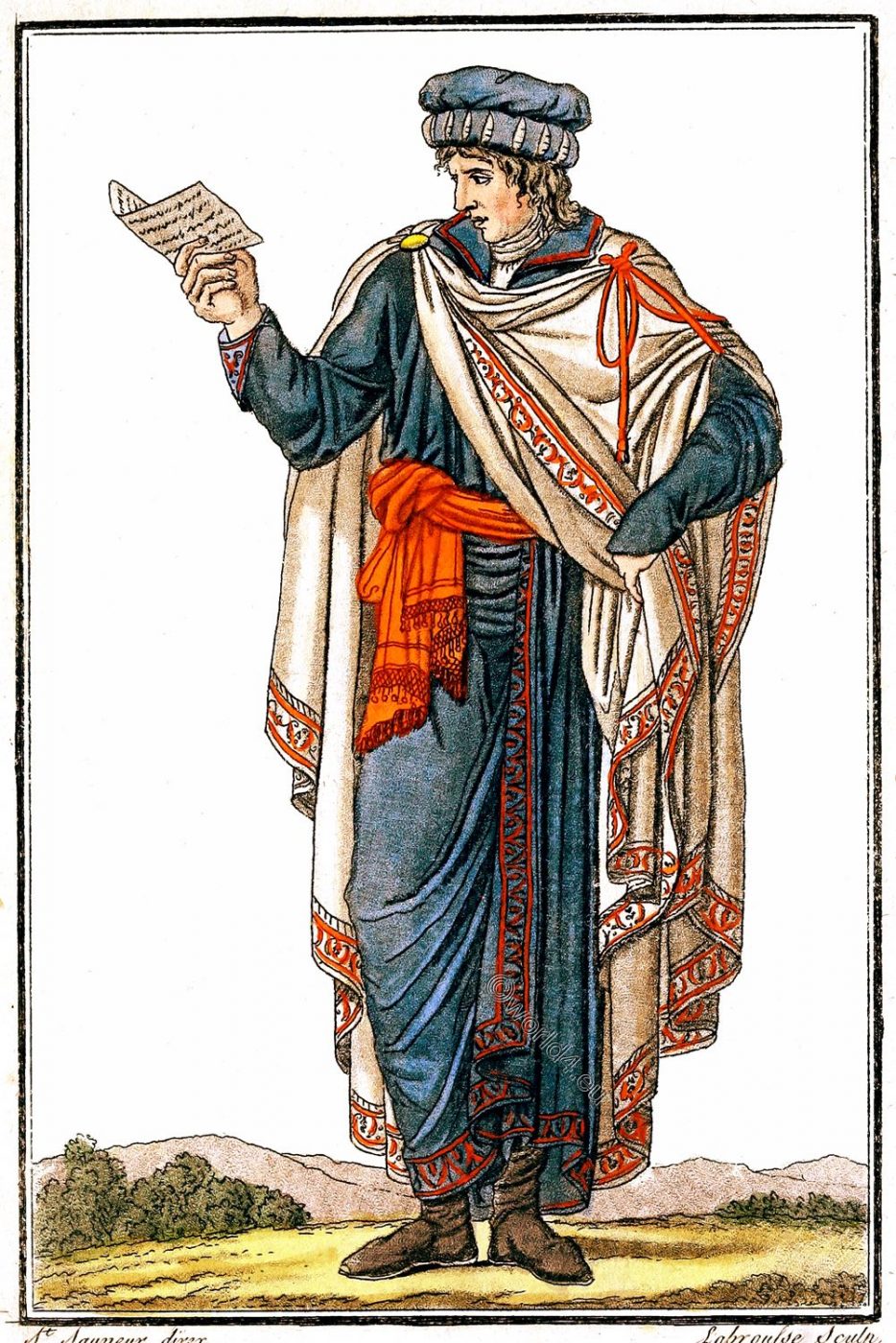

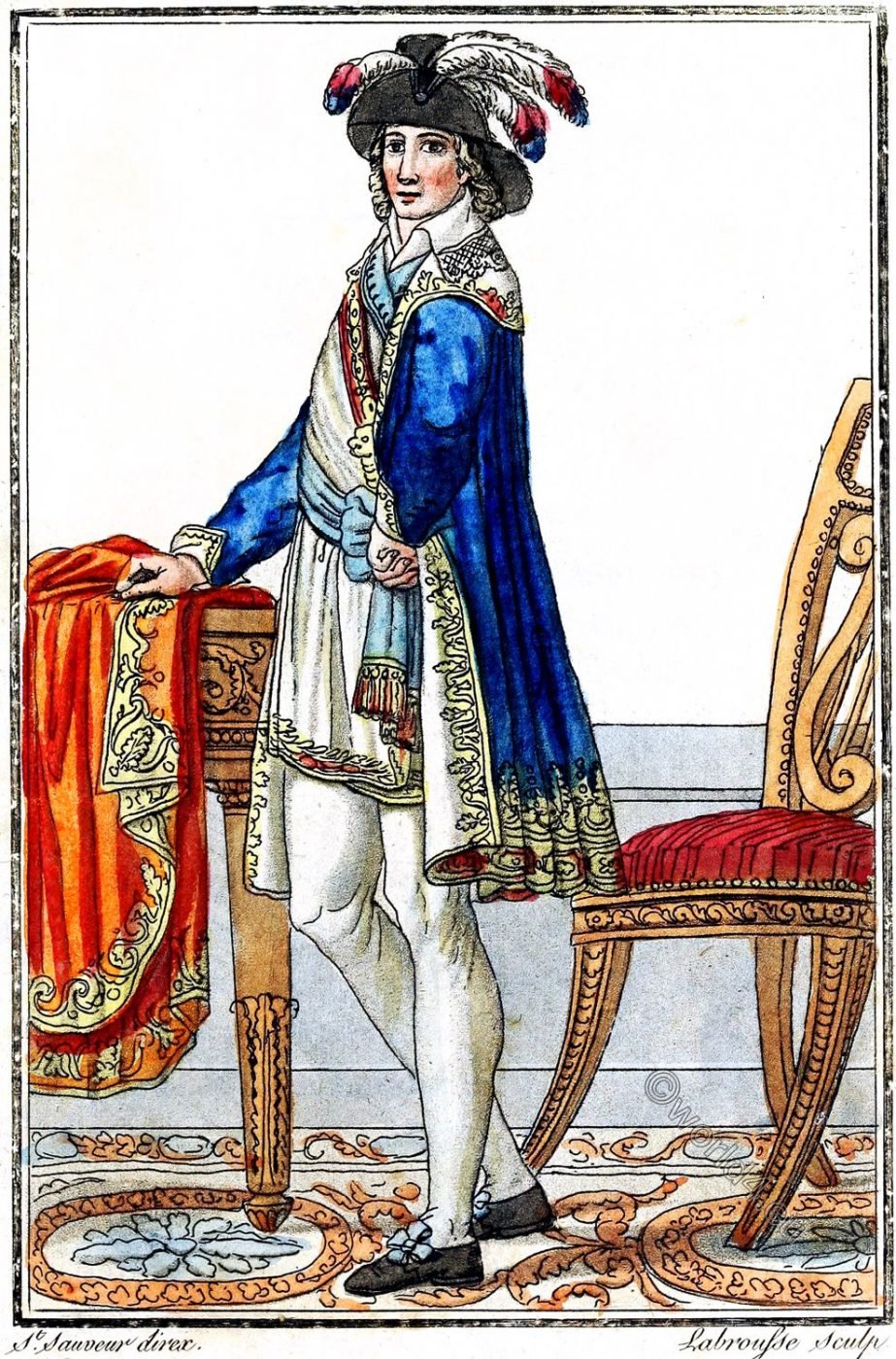
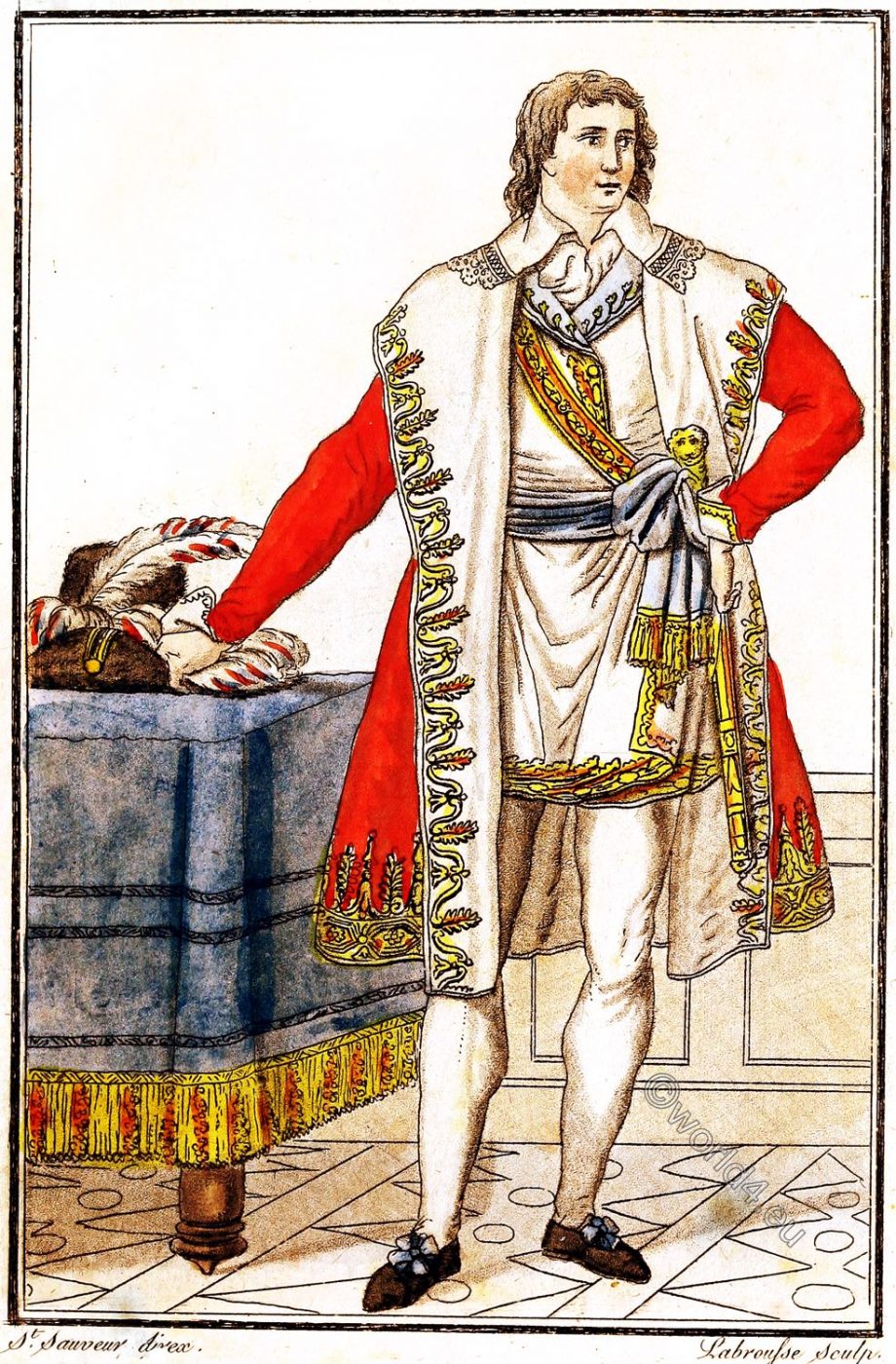
That of the Ancients and the Council of the Five Hundred seems literally copied from the great Roman toga. It is in itself a very noble and picturesque costume, but inasmuch as it differs too widely from the everyday dress of the nation, it acquires, from that very fact, a certain theatrical air, a look of artificiality.
Still this does not prevent its having, at any rate for the time being, a serious and genuinely imposing dignity. Indeed, there is nothing perhaps that must not appear preferable to the slovenliness, disorder and dirtiness of the costume of the day.
Such of these gentlemen as are the best dressed wear a blue coat, a red or black waistcoat and boots of soft leather. Travellers newly arrived from Paris have assured me that the majority of members still wore their old dress, and that, even at public sittings, you saw very few who deigned to take the trouble to don their long gowns.
“What, without any question, cannot but strike the spectator as far more imposing than either the old or the new costume of the Deputies, is the appearance of their military bodyguard, the gendarmes of the Convention, as they are called. I do not know precisely how many men make up this new Praetorian Guard; but it is enough to see them on parade to judge that it is a carefully picked corps. All are fine men, well uniformed and well armed. They include the elite of all the regiments of the line, among the rest many old Gardes Françaises; but the greater number are foreigners-Swiss, Germans, Swedes. It seems these popular kings are like other Monarchs, and hold that a foreign legion is to be preferred under certain circumstances to native or national guards.”
Above: XVIII Century. French school. Period of the Revolution. Artillery Museum in Paris. Guards swords and handles.
Above: XVIII Century. French school. Time of the French Revolution. Handles and scabbards of swords. Weapons of Honor.
“Since the days of the Constituent Assembly till the 18 Fructidor, the representatives of the people had had, even in the discharge of their functions, no special dress distinguishing them from other citizens. The costumes of the three orders disappeared with their fusion in the National Assembly.
The Conventionnels wore at their ceremonies only a simple tricolour scarf, to which those who were commissioned to the Armies in the field added a plume of the same colours. After the 9 Thermidor, when the Convention was fighting for life against all the factions, those of its members who boasted a warlike spirit would gird on the sword at the least threatening of danger. Merlin de Thionville, more soldier than legislator, went further and let his moustaches grow.
“But after the 18 Fructidor, the representatives of the people were accorded the senatorial purple, as kings are decked out even after death with all the insignia of Royalty – a poor form of flattery that in no wise saves the princely bodies from putrefaction or their names from oblivion!
“The Directoire had been given the robes of chivalry and the feudal age, the Councils the costume of Greece and Rome. Nothing more grotesque than La Revellière in this dress, nothing more podgy and ridiculous than certain deputies in those flowing robes! The Directors deemed themselves veritable Bayards, and the Representatives Aristides and Catos.
“When the question was debated of adopting costumes, many able men, following the views of Jean-Jacques Rousseau, believed in the good influence they were likely to exert, and looked upon the insignia of power as giving dignity and weight… . There were two distinct political sects on the question, like Catholics and Protestants in religion; one was for commanding respect by the external apparatus of power, the other by simplicity and good laws.
The example was quoted of the only two free peoples on earth, England and the United States, where the representatives have no distinctive dress. Against this were cited the clergy of the Catholic Church and the Republics of Antiquity. The costume sect carried the day.
“As for the particular form adopted, no political reason decided this, but rather the wishes of artists and the vanity of the wearers. Feudal mantles and classic togas were more favourable to the arts of painting and sculpture, and both among Directors and Deputies some were to be found not insensible to the satisfaction of going down to posterity by the chisel of Houdon or the brush of David.
“The Directoire, from its first installation, wore its costume. Various circumstances prevented the Corps Législatif from assuming its dress in the first instance. No cloth fine enough could be procured in France, so the cloaks of the representatives of the French people were ordered from England. They were seized at the frontier as contraband goods, and the officers of the douane gave a lesson to our Legislators.” (Thibaudeau, Mémoires,-” Directoire,” ii., ch. 32, p. 331.)
Barras’ little joke
This last incident would seem to have been contrived by Barras, who sent secret orders to the frontier officers – or at any rate is very strongly suspected of having done so – for the express purpose of putting the Legislature in an absurd and equivocal position. The difficulty was, of course, only momentary.
To conclude, we will let a lady say her word on this eminently feminine subject of dress. The authoress of the Sketch writes from Paris, December 4, 1796: “… Let me add a word or two concerning their manner of dressing; for surely never was fashion and luxury carried at Paris to greater excess than at present; and at the opera… the females are ornées with as much taste and coquetry as ever.
Fashion may be said to have resumed all its former influence, and to become amongst the French, as heretofore, an important affair of business. The first night we attended this theatre I was extremely inquisitive, and asked a thousand questions concerning the dresses, company, etc.
A lady who was seated in the same box very politely took the trouble to explain things to me… . After showing me a few of the most fashionable women, among whom was Madame Tallien, she asked me, whether I did not think her extremely handsome, and her dress charming ? – and then, before I could possibly answer – ‘It matters not, however,’ added she, ‘what she wears, for she sets everything off to the greatest advantage; yet, as you appear to be a stranger, I would recommend you to notice her dress, it being the newest taste, and called robe ronde à la Flore; surely nothing can be more becoming.
The lady,’ continued she, ‘that is seated on the right of Madame Tallien, is dressed à la Bérênice, and the other on the left à la Cérès; those three charming young women you see in the front seat have on des redingottes à la Galatée, a dress, in my opinion, preferable to the former, from its fitting the shape with nicety, and exhibiting it to the greatest advantage; but in short, we have such a variety, and all so elegant, that you will be puzzled which to admire most. …There are two in the next box to us, which, from being much worn by les femmes comme-il-faut, I must also recommend to your notice, – the one in white is called l’habillement au lever d’Aurore, and the other in blue, au coucher du Soleil; they are both uncommonly pretty, and certain of pleasing those who have a just idea of taste and fashion.’ …Things are, however, wonderfully changed within these two years; for then nothing was seen but des habits à la Houssards – à la Sansculottes – à la Jacobine – à la Guillotin – et même à la Monarchie détrônée (Hussar, Sansculottes, Jacobin, Guillotine, and even ‘dethroned monarchy’ costumes). Was ever anything so horrible?
“The extreme change that is so conspicuous, and has since the death of Robespierre taken place in the character and dress of the major part of the Parisians, appears to have equally influenced their political ideas, and even affected their principles of religion; for nothing is more certain than that the generality of those who, during the Reign of Terror, were either atheists or deists, are now become most violent advocates and fervent apostles, bordering on bigotry, in behalf of the religion they then scoffed at.”
Tremendous effects indeed to have followed from a change of dress, however conspicuous. But perhaps the amiable writer of the letter does not quite mean what she says; and there is no doubt vast modifications of political opinion and religious belief did accompany the introduction of these new fashions, which were in their degree signs of the times.
Source: The days of the Directoire by Alfred Allinson with a note upon the costume of the period by John Colby Abott.
Related
Discover more from World4 Costume Culture History
Subscribe to get the latest posts sent to your email.




